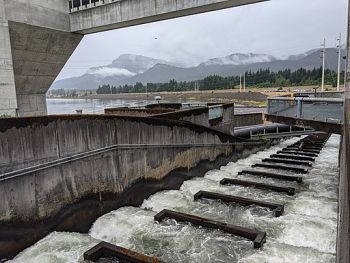Aquatic Life Movement

|
| Fish ladder at Bonneville Lock and Dam. |
"Many dams in the Western United States are more than 75 years old and were constructed for irrigation, power generation, recreation, and flood control as part of the development of the Western United States. 'Human habitation in the West as we know it would not be possible witout this kind of active control and use of its surface water resource. Though vilified by many for the environmental damage they have caused, dams provide important, essential functions now relied upon to some degree by virtually every person who lives in the West' (MacDonnell, 1999). During early development, there was little information available about the life history requirements of resident an migratory fish species, and little consideration was given to their needs, especially in-stream migratory behavior. In many cases, dam construction has impeded fish movement and contributed to declining fish populations by limiting access to suitable spawning, rearing, and foraging habitat. Although significant attention bas been given to understanding anadromous fish behavior and passage needs, very little attention has been given to other native fish. During the past 100 years, some 21 species and subspecies among 6 fish families have become extinct from the 17 Western States; some 64 species and subspecies are now Federally listed as threatened or endangered (Minckley and Deacon, 1992). Most of these species declines are related to alteration of habitat and the detrimental effects of non-native fishes. Recovery of threatened and endangered fish species requires reestablishing access to natural spawning, rearing, and forage areas."[1]
"Fish protection is an important aspect of fishery management at water diversions. Fish protection is often defined as fish exclusion from water diversions. Protection includes not only limiting entrainment of fish at diversions, but also protecting fish from injury or mortality resulting from operation of the diversion. The death and injury of fish at water diversions have long been identified as major sources of fish mortality (Spencer, 1928; Hallock, 1977). Fish entrained into agricultural or municipal and industrial diversions can experience nearly 100 percent mortality. Fish entrained into power intakes incur high mortality, and also experience injuries and disorientation that can lead to increased predation losses. A recent study on a seasonal irrigation canal associated with the Shoshone River in northwestern Wyoming provided insight into the potential for fish entrainment into these irrigation diversion systems. A total of 5,732 fish of 11 species were collected from a combined 5 miles of three canals by electro fishing, block netting, and draining techniques (Karp et al., 1993)."[1]
Best Practices Resources
![]() Fish Protection at Water Diversions, USBR, 2006
Fish Protection at Water Diversions, USBR, 2006
Trainings
![]() On-Demand Webinar: Introduction to Nature-Like Fishways for Dams
On-Demand Webinar: Introduction to Nature-Like Fishways for Dams
Citations:
Revision ID: 5182
Revision Date: 12/12/2022
